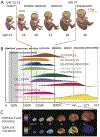Early brain activity: Translations between bedside and laboratory
- PMID: 35364141
- PMCID: PMC9923767
- DOI: 10.1016/j.pneurobio.2022.102268
Early brain activity: Translations between bedside and laboratory
Abstract
Neural activity is both a driver of brain development and a readout of developmental processes. Changes in neuronal activity are therefore both the cause and consequence of neurodevelopmental compromises. Here, we review the assessment of neuronal activities in both preclinical models and clinical situations. We focus on issues that require urgent translational research, the challenges and bottlenecks preventing translation of biomedical research into new clinical diagnostics or treatments, and possibilities to overcome these barriers. The key questions are (i) what can be measured in clinical settings versus animal experiments, (ii) how do measurements relate to particular stages of development, and (iii) how can we balance practical and ethical realities with methodological compromises in measurements and treatments.
Keywords: Animal model; Biomarker; Cerebral cortex; Development; Human; Neuronal activity.
Copyright © 2022 Elsevier Ltd. All rights reserved.
Figures




References
-
- Adle-Biassette H, Golden JA, Harding B, 2017. Developmental and perinatal brain diseases. Handb Clin Neurol 145, 51–78. - PubMed
-
- Ahtola E, Stjerna S, Tokariev A, Vanhatalo S, 2020. Use of complex visual stimuli allows controlled recruitment of cortical networks in infants. Clin Neurophysiol 131, 2032–2040. - PubMed
-
- André M, Lamblin MD, d'Allest AM, Curzi-Dascalova L, Moussalli-Salefranque F, The SN, Vecchierini-Blineau MF, Wallois F, Walls-Esquivel E, Plouin P, 2010. Electroencephalography in premature and full-term infants. Developmental features and glossary. Neurophysiol. Clin 40, 59–124. - PubMed
Publication types
MeSH terms
Grants and funding
LinkOut - more resources
Full Text Sources

